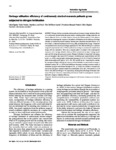Please use this identifier to cite or link to this item:
http://www.alice.cnptia.embrapa.br/alice/handle/doc/1012912| Title: | Herbage utilisation efficiency of continuously stocked marandu palisade grass subjected to nitrogen fertilisation. |
| Authors: | PEREIRA, L. E. T.  PAIVA, A. J.   GUARDA, V. D. A.   PEREIRA, P. de M.   CAMINHA, F. O.   SILVA, S. C. da   |
| Affiliation: | LILIAN ELGALISE TECHIO PEREIRA, USP; ADENILSON JOSE PAIVA, ESALQ; VITOR DEL ALAMO GUARDA, CNPASA; PRISCILA DE MESQUITA PEREIRA, ESALQ; FABIO OLEGARIO CAMINHA, ESALQ; SILA CARNEIRO DA SILVA, ESALQ. |
| Date Issued: | 2015 |
| Citation: | Scientia Agricola, Piracicaba, v. 72, n. 2, p. 114-123, Mar./Apr. 2015. |
| Description: | Nitrogen fertiliser accelerates plant growth and increases herbage utilisation efficiency in continuously stocked temperate grass swards, indicating greater herbage production and harvest efficiency. There is no similar evidence, however, for tropical pastures. In this study we evaluated the morphogenetic responses, the patterns of defoliation and the efficiency of herbage utilisation of continuously stocked marandu palisade grass (Brachiaria brizantha (Hochst. ex A. Rich.) Stapf. cv. Marandu) maintained at 30 cm by cattle and fertilised with nitrogen. Treatments corresponded to four measures of nitrogen application (0, 150, 300 and 450 kg ha?1), and were assigned to experimental units (1,200 m2 paddocks) according to a randomised complete block design, with four replications. There was a seasonal pattern of variation in the morphogenetic responses and in herbage utilisation efficiency (HUE) characterised by higher herbage growth rates and HUE during late spring and summer. Nitrogen fertilisation increased both leaf appearance and elongation rates (around 60 % between non-fertilised and swards fertilised with 450 kg ha?1, p < 0.05), requiring higher stocking rates (average of 1.6, 2.6, 2.9 and 3.1 Animal Unit (adult animal weighing 450 kg) ha?1 for 0, 150, 300 and 450 kg ha?1, respectively) to maintain the management target. Although the frequency of leaf defoliation increased (with no change in defoliation severity - 56.1 ± 1.88 %), the leaf lifespan decreased, resulting in a similar number of defoliations during the leaf lifespan (average of 0.91 ± 0.069). This resulted in increased HUE only for the 150 kg ha?1 treatment relative to non-fertilisation (37.5, 48.1, 44.0 and 44.5 ± 2.25 % for 0, 150, 300 and 450 kg ha?1 N, respectively), indicating that with nitrogen fertilisation rates above 150 kg ha?1, there are compensatory mechanisms related to morphogenetic responses that buffer changes in utilisation efficiency. |
| Thesagro: | Brachiaria brizantha Fertilizante nitrogenado Manejo Forragem |
| NAL Thesaurus: | Grazing management Defoliation Forage |
| DOI: | 10.1590/0103-9016-2014-0013 |
| Type of Material: | Artigo de periódico |
| Access: | openAccess |
| Appears in Collections: | Artigo em periódico indexado (CNPASA)  |










